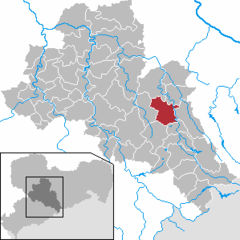Freiberg | |
|---|---|
view over Freiberg from St Peter's Church town hall old town from above Obermarkt Freiberger Christmarkt | |
Location of Freiberg within Mittelsachsen district  | |
| Coordinates: 50°54′43″N 13°20′34″E / 50.91194°N 13.34278°E | |
| Country | Germany |
| State | Saxony |
| District | Mittelsachsen |
| Subdivisions | 8 |
| Government | |
| • Mayor (2022–29) | Sven Krüger[1] |
| Area | |
| • Total | 48.05 km2 (18.55 sq mi) |
| Elevation | 400 m (1,300 ft) |
| Population (2022-12-31)[2] | |
| • Total | 40,485 |
| • Density | 840/km2 (2,200/sq mi) |
| Time zone | UTC+01:00 (CET) |
| • Summer (DST) | UTC+02:00 (CEST) |
| Postal codes | 09599, 09596 |
| Dialling codes | 03731 |
| Vehicle registration | FG |
| Website | www.freiberg.de |
Freiberg is a university and former mining town in Saxony, Germany, with around 41,000 inhabitants. The city lies in the foreland of the Ore Mountains, in the Saxon urbanization axis, which runs along the northern edge of the Elster and Ore Mountains, stretching from Plauen in the southwest via Zwickau, Chemnitz and Freiberg to Dresden in the northeast. It sits on the Freiberger Mulde, a tributary of the Mulde River. It is a Große Kreisstadt (large district town), and the administrative seat of Landkreis Mittelsachsen (district Central Saxony). Freiberg is connected to Dresden by the S3 line of the Dresden S-Bahn.
The entire historic center of the Silver City is under monument protection, and together with local monuments of mining history such as the Reiche Zeche ore mine, it has been part of the UNESCO World Heritage Site Erzgebirge/Krušnohoří Mining Region since 2019 due to its exceptional testimony to the development of mining techniques across many centuries.[3]
Freiberg University of Mining and Technology (Technische Universität Bergakademie Freiberg), founded in 1765, is the oldest university of mining and metallurgy in the world. Until 1969, the town was dominated for around 800 years by the mining and smelting industries. Since then it has restructured into a high technology site in the fields of semiconductor manufacture and solar technology, part of Silicon Saxony.
Freiberg Cathedral is one of the most richly furnished houses of worship in Saxony and contains important works of art such as the tulip pulpit, two Gottfried Silbermann organs, the choir, which was converted into a burial place for the Albertines, and the Golden Gate (Goldene Pforte), of which exist three replicas in Cambridge, Massachusetts, Moscow and Budapest.
Freiberg's christmas market Freiberger Christmarkt is typical for christmas markets in the Ore Mountain region, which are characterized by a strong connection to mining and the typical christmas decorations of this region like Raachermannel, Schwibbögen and Christmas pyramids.
- ^ Gewählte Bürgermeisterinnen und Bürgermeister im Freistaat Sachsen, Stand: 17. Juli 2022, Statistisches Landesamt des Freistaates Sachsen.
- ^ "Einwohnerzahlen nach Gemeinden als Excel-Arbeitsmappe" (XLS) (in German). Statistisches Landesamt des Freistaates Sachsen. 2024.
- ^ "Erzgebirge/Krušnohoří Mining Region". UNESCO World Heritage Centre. United Nations Educational, Scientific, and Cultural Organization. Retrieved 9 June 2021.









